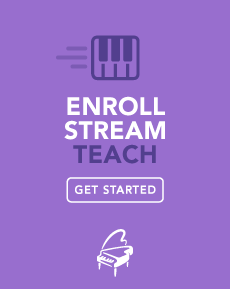Make Practice Perfect
Found in: Coaching

Can you think of any activity in your life that you were perfect at the very first time you did it? Here are a few things that that applies to for me:
- Contactless credit card payments
- Using velcro
- Wearing shoes (especially if secured with velcro)
- Eating chocolate
- Laughing
- Scratching itches
- Watching TV (if already turned on)
- Petting a cat
For me, anything more complex than the above examples has taken a little effort. Some tasks can be perfected pretty quickly, but some pursuits are the kind of thing where you never reach total mastery. Playing a musical instrument is an obvious example – like a fractal, you keep zooming in and finding deeper challenges; new details to discover and explore. That can be exactly what’s exciting about it, so long as you recognise it as a journey with no final destination. The trick is to enjoy the journey.
As a Simply Music student, you’ll know about the peaks, plateaus and valleys on this endless journey. And there’s one constant, one vehicle that keeps you constantly moving forward – practice.
How do you practice?
Practice in itself is a skill. If you take the time to learn that skill well, it will pay itself off in spades, because it’ll speed up the time it takes to perfect any task. I often wish I was a fly on the wall in my students’ music room as they practice, because I’m not always convinced they think too hard about how they practice. They do what I ask them, but sometimes I fear that are doing so a little thoughtlessly. They expect that they will complete the task if they simply repeat it enough. And that’s usually true, but I can promise you that repetition in and of itself is not the most efficient way to complete most tasks. Of course, repetition is unavoidable, but mindless repetition is relatively useless, compared to conscious, focused, planned, strategic practice.
Losing your focus as you go through the necessary repetition is all too easy. As humans, our minds are inclined to wander and our learning decline as we repeat. But there are some ways of structuring your practice that will help keep you on the ball. For example, if it’s true that we naturally lose concentration after a certain time, we might work best if we don’t spend too long on one task. We can train ourselves over time to get better at focusing on a task, but whatever our ability to focus, we can get the best from our time by knowing ourselves and our focus levels. Here are a few ideas:
If you lose concentration, stop for a moment – Let go of the keys, take a breath and reset your brain.
Try shorter but more frequent practice sessions. Instead of slogging through 20 minutes in one session, see if you concentrate better with two ten minute sessions, or even four five minute sessions. As you develop your mindfulness skills, you may be able to stretch them out gradually.
For most tasks, do no more than a few minutes per task – Research has found that after 5-10 minutes per task, you get less value out of each repeat. You can try circuit-style – do a small amount on one task, move on to another, then come back to the first. Restarting the process can re-engage the brain.
Know the best dosage. One of the features of learning the Simply Music way is that you will usually be given a very specific task. In his development of the program, Neil Moore, aided by the experience of countless teachers, has discovered the steps for each project that have been found to be the right amount to process in a given time. So make sure you know exactly the task your teacher has given you, aided by the references in your Student Materials. But even better than that, be your own best method coach. If your assigned task is too big, reduce it. A really useful yardstick is ‘Three Times in a Row’. If you can’t get to the point of successfully playing the task three times in a row within a reasonable time frame (your guide could be if you do it wrong three times in a row), you are simply doing too much. So do less! Break down the task into smaller components, go back a step, or go slower so you can be better in control.
Be careful that you are practicing only what you need to practice. If you’re working on a small passage in the middle of a piece, are you tempted to start again at the beginning? Getting a ‘run up’ might be important if you’re practicing pole vaulting, but with piano it’s probably a waste of time. Or worse – if you can only play a passage by starting from somewhere earlier, it probably means you are over-relying on muscle memory. This is further encouragement to switch off your brain and not learn deeply.
Getting better at getting better
Since, as I mentioned earlier, practice itself something you can improve at, I suggest you include ‘developing practice skills’ as part of your regular practice tasks. It’s easy to do because it adds no more time to your session – you’re simply thinking about the best ways to practice while you practice.
And you might even find that developing your mindfulness and strategic thinking at your instrument can flow through to other activities in your life.
 This post is adapted from Gordon’s new program in the Creative Coaching Series, Practice for the Busy Person. In almost two hours of audio conversations accompanied by summary notes and including practical activities, Gordon explores the question of practice in a comprehensive, accessible and inspiring way. The program is great for students, teachers and parents, and contains gems of wisdom helpful for anyone looking to improve themselves at just about any endeavour.
This post is adapted from Gordon’s new program in the Creative Coaching Series, Practice for the Busy Person. In almost two hours of audio conversations accompanied by summary notes and including practical activities, Gordon explores the question of practice in a comprehensive, accessible and inspiring way. The program is great for students, teachers and parents, and contains gems of wisdom helpful for anyone looking to improve themselves at just about any endeavour.








